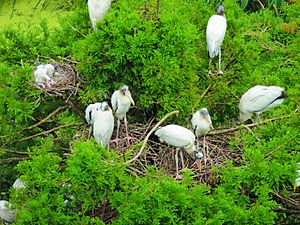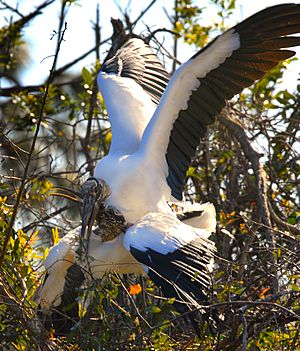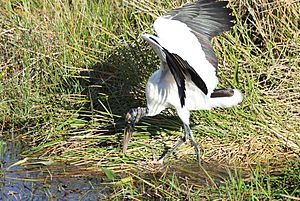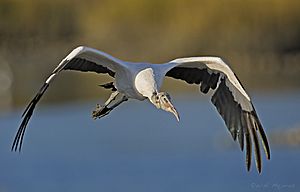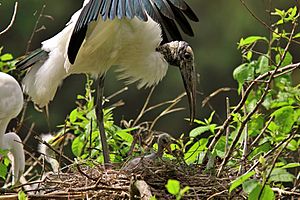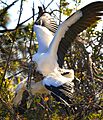Wood stork facts for kids
Quick facts for kids Wood stork |
|
|---|---|
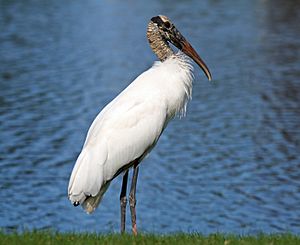 |
|
| Pond, Tampa Bay, Florida |
|
| Conservation status | |
| Scientific classification | |
| Genus: |
Mycteria
|
| Species: |
americana
|
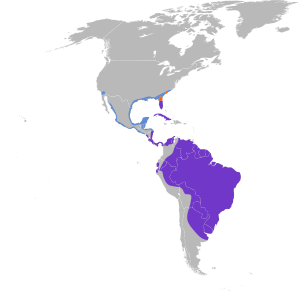 |
|
| Note: Map is missing the distribution on Hispaniola and Jamaica | |
| Synonyms | |
|
Tantalus loculator Linnaeus, 1758 |
|
The wood stork (Mycteria americana) is a large wading bird found in the Americas. It belongs to the stork family, Ciconiidae. This bird was once called the "wood ibis," but it is not a true ibis.
You can find wood storks in warm, wet places across the Americas, including the Caribbean. In South America, they live there all year. In North America, they often travel as far north as Florida. This stork was first described by Carl Linnaeus in 1758. It likely developed in tropical areas.
Wood storks have a bare, dark grey head and neck. Their bodies are mostly white. Their tail and some wing feathers are black with a shiny green-purple color. Young wood storks look different from adults. They have feathers on their heads and a yellow bill. Adult storks have a black bill. Males and females look very similar.
Wood storks need habitats with changing water levels. Their large nests, about 1 meter (3 feet) wide, are built in trees. These trees are often mangroves or Taxodium trees. Nests are usually over or surrounded by water. Wood storks nest in large groups called colonies.
They build their nests from sticks and green plants. The breeding season starts when water levels drop. This can happen from November to August. They lay one group of three to five eggs. The eggs hatch after about 30 days. Young chicks need their parents' help to survive. They learn to fly 60 to 65 days after hatching. Sadly, only about 31% of nests successfully raise a chick each year. Most chicks die in their first two weeks, even with an adult watching them. Parents feed the chicks fish that get bigger as the chicks grow.
Adult wood storks eat different foods throughout the year. In the dry season, they eat fish and insects. In the wet season, they also eat frogs and crabs. They find food by touching with their bill, not by seeing. This means they need shallow water to catch food well. This is also why they breed when water levels start to fall.
Globally, the wood stork is considered a species of Least Concern. This is because it lives across a very large area. However, in the United States, it is considered a threatened species.
Contents
What is a Wood Stork?
Naming and History
The wood stork was first officially named Mycteria americana by Carl Linnaeus in 1758. The name Mycteria comes from a Greek word meaning "snout." The word americana refers to where this stork lives, in the Americas.
This bird likely developed in warm, tropical regions. Its presence in North America probably happened after the last ice age. Scientists have found old bone pieces of a larger, extinct relative called M. wetmorei. This older stork lived in North America.
The wood stork has also been called the "wood ibis" because of its curved bill. Other local names include "flinthead" and "preacher."
How to Identify a Wood Stork
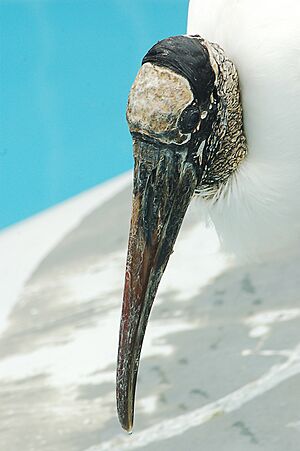
Adult wood storks are large birds. They stand about 83 to 115 centimeters (33 to 45 inches) tall. Their wings can spread out 140 to 180 centimeters (55 to 71 inches) wide. Males usually weigh between 2.5 and 3.3 kilograms (5.5 to 7.3 pounds). Females are a bit lighter, weighing 2.0 to 2.8 kilograms (4.4 to 6.2 pounds).
The adult's head and neck have no feathers. Their skin there is dark grey and looks scaly. Their long, black bill curves downwards and is very wide at its base. Most of their body feathers are white. However, their main flight feathers and tail feathers are black. These black feathers have a shiny green and purple color. Their legs and feet are dark. During breeding season, their toes turn pink. Males and females look very much alike.
When wood stork chicks first hatch, they have thin grey fuzz. After about 10 days, this fuzz is replaced by thick, white downy feathers. Chicks grow very quickly. In just three to four weeks, they are about half the size of an adult. By six or seven weeks, the feathers on their head and neck turn smoky grey. When they are ready to fly, they look like adults. The only differences are their feathered heads and yellow bills.
Where Wood Storks Live
This bird lives in warm, wet areas called subtropical and tropical regions. They breed in many parts of South America, Central America, and the Caribbean. The wood stork is the only stork that breeds in North America. In the United States, small groups breed in Florida, Georgia, and the Carolinas. In South America, they are found as far south as northern Argentina. Some North American storks fly south to South America after breeding.
Wood storks can live in different types of wetlands. They need places where water levels change. This change helps them start breeding. They build their nests in trees that are over or surrounded by water. In freshwater areas, they prefer to nest in Taxodium trees. In coastal areas, they often nest in mangrove forests.
To find food, they use freshwater marshes where Taxodium trees grow. In mangrove areas, they feed in salty water. If there are many lakes, they will feed along the edges of lakes, streams, and rivers.
Wood Stork Behavior
Breeding and Life Cycle
Wood storks live and breed in lowland wetlands with trees. They build large nests made of sticks in trees. In freshwater areas, they like to nest in wider trees. They nest in groups called colonies. Up to 25 nests can be found in a single tree. The height of these nests varies. Some nests in shorter mangrove trees are about 2.5 meters (8 feet) high. Nests in taller mangrove trees can be around 6.5 meters (21 feet) high. In Taxodium trees, they usually nest near the top branches, often 18 to 24 meters (59 to 79 feet) above the ground. They choose forks in large branches or where many branches cross.
The male stork builds the nest. He uses sticks and green twigs collected from the colony area. Greenery is usually added after the main stick structure is done, but before eggs are laid. Less greenery is added after the eggs hatch. This greenery helps keep the nest warm. A finished nest is about 1 meter (3 feet) wide. The central area for eggs is about 28 centimeters (11 inches) wide. The edges of the nest are usually 12 to 20 centimeters (5 to 8 inches) thick.
Sometimes, wood storks without a nest try to take over another pair's nest. More than one bird will try to do this. They throw out the young birds and eggs within about 15 minutes. If only one stork is guarding the nest when it is taken over, it usually waits for its mate to try to get the nest back.
Breeding starts when water levels drop and there are more fish. This is because lower water levels and more fish mean enough food for the young chicks. Breeding can happen anytime between November and August. Once it starts, breeding takes about four months to finish.
This bird lays one group of three to five cream-colored eggs. Each egg is about 68 by 46 millimeters (2.7 by 1.8 inches). Eggs are usually laid one or two days apart. Both parents take turns sitting on the eggs for 27 to 32 days. This incubation period starts when the first egg is laid. During the first week, parents stay close to the colony. They only leave for short trips to find food, drink, and gather nest material. After the first week, the non-incubating bird spends less time in the colony. However, the eggs are never left alone. After a few hours of sitting, the bird might take a break to stretch, clean its feathers, move nest material, or turn the eggs. The eggs hatch in the same order they were laid, with a few days between each hatching.
Newly hatched chicks are helpless and cannot move. They weigh about 62 grams (2.2 ounces). Parents keep them warm for the first week. After that, they are only kept warm when it rains or at night. Chicks are not left alone until they are at least three weeks old. One parent finds food while the other guards the nest and chicks. When chicks are three weeks old, they are big enough to protect the nest themselves. At this age, they also become more aggressive towards anything new or strange. They learn to fly 60 to 65 days after hatching. They can start having their own chicks when they are four years old. However, they usually don't successfully raise chicks until they are five.
About 62% of wood stork nests have at least one egg hatch each year. This can change a lot, from 26% to 89% in different colonies. Chicks are most likely to die between hatching and two weeks old. Overall, about 31% of nests successfully raise at least one young bird that can fly. Raccoons and crested caracaras are major predators of eggs and chicks. Nests can also fail if they fall, breaking the eggs inside. This can happen due to poorly built nests or fights between adult storks.
Feeding Habits
In the dry season, wood storks mainly eat fish. They also eat some insects. In the wet season, fish make up about half of their diet. Crabs make up about 30%, and insects and frogs make up the rest. Wood storks prefer to eat larger fish, even if smaller fish are more common. An adult wood stork needs about 520 grams (1.1 pounds) of food each day. A whole family needs about 200 kilograms (440 pounds) of food during one breeding season.
When not breeding, wood storks usually look for food in groups. When breeding, they forage alone or in small groups. In the dry season, they often walk slowly with their bill underwater, feeling for food. In the wet season, they use this method about 40% of the time. During the wet season, they also use a method called "foot stirring." The stork walks very slowly with its bill in the water. Before each step, it pumps its foot up and down. Both of these hunting methods do not rely on seeing the food.
Because they don't see their food, wood storks need shallow water and many fish to find food successfully. In the dry season, they feed in water about 17 centimeters (6.7 inches) deep. In the wet season, the water is usually about 10 centimeters (3.9 inches) deep. In the dry season, they prefer water without plants sticking out. In the wet season, they like areas where plants stick out about 10 to 20 centimeters (3.9 to 7.9 inches) above the water. These birds can travel over 80 kilometers (50 miles) to find good feeding spots.
Both parents feed their chicks by bringing up food onto the nest floor. Chicks are mainly fed fish that are 2 to 25 centimeters (0.8 to 9.8 inches) long. The fish usually get longer as the chicks get older. The amount of food chicks get changes over time. They eat more each day from hatching until about 22 days old. Then, food intake stays steady until about 45 days, when it starts to decrease. Overall, a chick eats about 16.5 kilograms (36 pounds) of food before it can fly.
Flight and Movement
Wood storks use two main ways to fly. When it's not warm and clear, like in the late afternoon or on cloudy days, they flap their wings and then glide for short times. When it's warm and clear, they fly up to at least 610 meters (2,000 feet) by flapping their wings. Then, they can glide for 16 to 24 kilometers (10 to 15 miles). They don't need to flap their wings during this time. This is because warm air currents, called thermals, are strong enough to hold them up. Soaring saves energy, so storks use this method to fly to places farther away. They fly with their neck stretched out and their legs and feet trailing behind them.
When flying to find food, wood storks fly at an average speed of about 24.5 kilometers per hour (15.2 miles per hour). When flapping their wings, they fly at about 34.5 kilometers per hour (21.4 miles per hour). When gliding, they fly at about 20 kilometers per hour (12 miles per hour).
Staying Cool
During breeding season, adult wood storks often poop over the edge of their nest. Chicks usually poop inside the nest. How adults poop changes with the temperature. Normally, they lean forward and lift their tail slightly. The waste goes straight down or slightly backward.
When it's hot, the adult storks use a different method. They quickly move their tail downwards and forwards. They twist their body to aim at a leg that is bent backward. This is called urohidrosis. They switch which leg they aim at. The waste aimed at their legs is watery. It usually hits the middle of their unfeathered lower leg and runs down. This helps water evaporate, which cools the bird down. This cooling method starts when the temperature is a little above the point where they start panting. Panting begins at about 41.7 degrees Celsius (107.1 degrees Fahrenheit). Their normal body temperature is about 40.7 degrees Celsius (105.3 degrees Fahrenheit). In hot weather, breeding adults also use their wings to shade their chicks.
Threats to Wood Storks
Raccoons are predators of wood stork chicks. This is especially true during dry times when the water under nesting trees dries up. Where it lives, the crested caracara is a big predator of wood stork eggs. Other caracaras, hawks, and vultures also eat both eggs and chicks.
In the United States, the wood stork is considered threatened. From 1984 to 2014, it was even listed as endangered. This was due to fewer places to live and droughts. In Brazil, in the state of Santa Catarina, their numbers seem to be growing again. After being gone for many years, they are now seen regularly there.
People can also disturb nesting storks. A study found that nests with boats passing within 20 meters (66 feet) had fewer chicks survive. However, people watching from at least 75 meters (246 feet) away did not greatly affect nesting success. In the Everglades, human-built levees and drainage systems have changed when water levels rise and fall. This has shifted when storks nest, leading to fewer successful nests.
Images for kids
See also
 In Spanish: Tántalo americano para niños
In Spanish: Tántalo americano para niños




